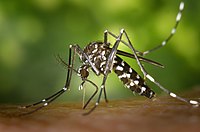
Photo from wikipedia
In many European countries, cemeteries are found to be suitable habitats for the proliferation of native and invasive mosquito species. The study aimed to assess for the first time in… Click to show full abstract
In many European countries, cemeteries are found to be suitable habitats for the proliferation of native and invasive mosquito species. The study aimed to assess for the first time in Poland the suitability of urban cemeteries for mosquito larvae development in water supply wells. From May to September 2019 in three urban cemeteries in Wroclaw (SW Poland), a total of 757 inspection of water supply wells were carried out. The mosquito larvae development, expressed as the general container index (GCI), differed between the examined areas and months of the study. The highest GCI value was calculated for Grabiszynski and Bujwida cemeteries (72.0 % and 59.3 % respectively). Larvae of three native mosquito species were identified in all inspected breeding places during the survey: Culex pipiens s.l. Linnaeus (95 %), Cx. torrentium Martini (4 %), Anopheles maculipennis s.l. Meigen (less than 1 %). No larvae of invasive Aedes mosquito species were found. In the inspected water supply wells larval productivity peaked in June, when the average temperature reached 22.7 °C. Due to the likelihood of the establishment and adaptation of invasive aedine mosquito species in Poland, constant analysis of the larvae composition in cemeteries should be continued.
Journal Title: International Journal of Tropical Insect Science
Year Published: 2021
Link to full text (if available)
Share on Social Media: Sign Up to like & get
recommendations!